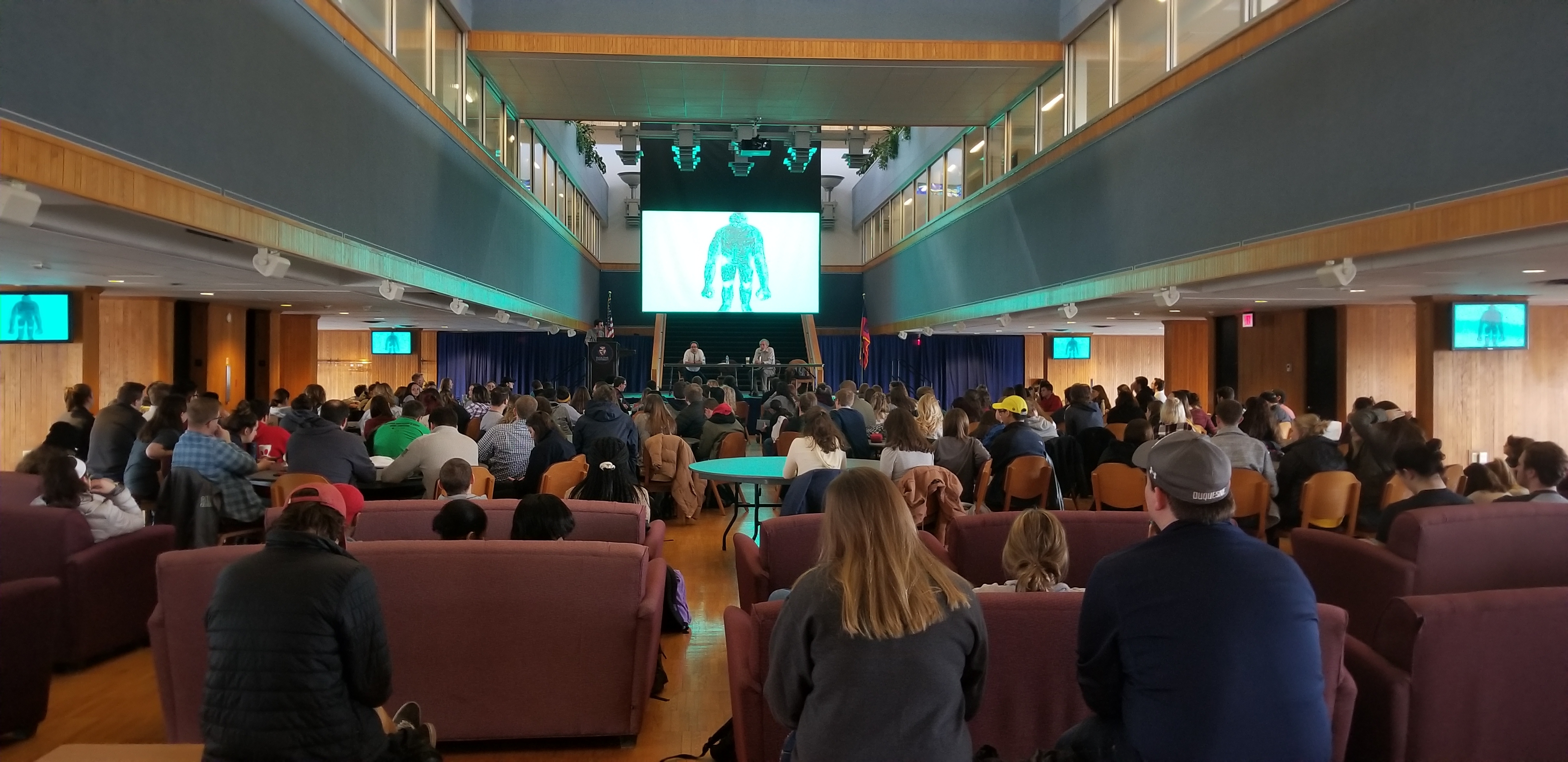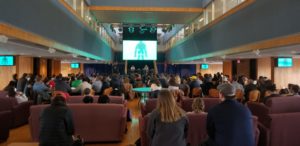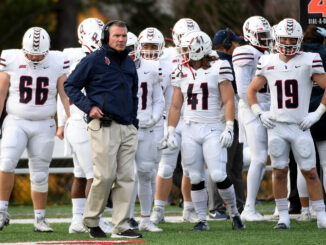

While the legend has changed over time, Bigfoot sightings date back almost 3000 years.
Nicolas Jozefczyk | A&E Editor
04/12/2018
The creature, the myth, the legend: Bigfoot took center stage at a riveting debate last Thursday, April 5. A resident assistant floor program, orchestrated by Carlee Shifko, an RA in Assumption Hall and PY1 pharmacy student, pitted two doctors of science against one another to answer once and for all — Is Bigfoot real?
Sean Tierney, Department of Mathematics and Computer Science instructor and moderator of the event, welcomed the crowd and gave his own thoughts on this tale. He explained that he grew up mostly with the Jersey Devil mythology, not so much Bigfoot. Tierney believes that it is possible for these creatures to exist in theory, but the people that say they have witnessed these creatures probably haven’t.
After the introduction, Charles Welsh, Department of Biological Sciences assistant professor and Bigfoot non-believer, explained his position. He started off his presentation by showing the “Sasquatch” Saturday Night Live skit as a comedic look at this so-called creature.
Welsh followed the video by clarifying that the “science” trying to prove Bigfoot’s existence, cryptozoology, is defined as, “a pseudoscience that aims to prove the existence of entities from the folklore record, such as Bigfoot.”
Holding a doctorate in biological sciences, Welsh brought his expertise to the forefront. He illustrated that the ape, Gigantopithecus, was the cause of this myth.
“This is more than likely the origin of Bigfoot, Sasquatch and Yeti lore,” Welsh said. Gigantopithecus went extinct 100,000 years ago, and humans have lived on the earth for 200,000 years, making his point that, “humans definitely saw this creature before it went extinct.”
Welsh continued on from his biological point by making more simplistic reasonings against Bigfoot’s existence. He mentioned that, while people might think they are seeing this mythological creature, it could really just be a grizzly bear.
Also, while believing in myths is fun, Welsh was skeptical that we have yet to find the creature. He ended his introduction by asking, “Do you think a creature this big can elude us this long?” and reaffirmed that he does not believe in Bigfoot.
Bringing the opposition was Paul Johnson, assistant professor and director of departmental affairs for the Department of Chemistry and Biochemistry.
Johnson started out by saying that he has never seen Bigfoot, but believes that the sightings are real. He first began looking at cases in 1977 and continued up until around 1997, investigating around 120 sightings in Pennsylvania.
Johnson explained that in the ’70s, people called the police when they thought something was amiss, such as a random creature on their property. Bigfoot groups would get calls from the police about the claim and investigate it themselves.
Those who would hunt for the animal had specialized lingo: Bigfoot was known as a Cryptic, a knocker was a piece of wood used to knock on trees or the ground and a screecher was a person or tape recording mimicking Bigfoot’s screech.
Per a student’s request, Johnson also talked about the UFO Bigfoot Boom of 1973. Around 1971 and 1972, most Bigfoot sightings came from the West Coast — Oregon, Washington and California. In 1972, however, there was an increase in UFO sightings on the East Coast, and at around the same time, the Bigfoot sightings also rose. In Western Pennsylvania alone, there were around 45 Bigfoot reports in 1972.
Interestingly, Johnson made clear that he does not believe in a flesh-and-blood Bigfoot. Rather, he believes that the beast is real when it is being seen and that it is not running around in the woods 24/7. Taking the idea of the Copenhagen interpretation that reality is created by observation, Johnson believes that when a person is observing Bigfoot, it exists, but when they are no longer, it is gone.
He closed by admitting this is just pure speculation and none of it can be proven. For those interested in learning more, he recommended a book and a movie: Silent Invasion: The Pennsylvania UFO-Bigfoot Casebook by Stan Gordon and Invasion on Chestnut Ridge, respectively. Johnson is currently working on the idea of string theory and Bigfoot, which he explains requires two assumptions: There is more than one universe and that wormholes exist.
After the two sides were presented, a question and answer session was held. When the event ended, The Duke was able to receive comments from the participants on how they thought the program went.
“[The event] was better than I could have expected.” Shifko said. “It was humbling to work with this great set of professors. I hope everybody that came enjoyed it.”
“It was an honor to hear Doctors Welsh and Johnson speak on the matter, but I am no closer to believing in the existence of Bigfoot nor dismissing it,” Tierney said.
“It was a great joy to engage in this event with Dr. Johnson. I am still a nonbeliever, but I learned a lot,” Welsh said.
“It was a pleasure to express my views on Bigfoot to such a large audience,” Johnson said.
Is Bigfoot real? The debate matched both sides against one another, but its effect on the student body’s belief has yet to be seen. One thing is for certain: The existence of Bigfoot is currently unknown, but it could be a matter of time until the mystery is solved.




